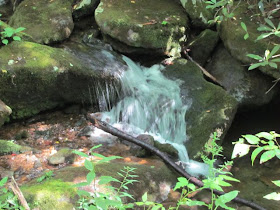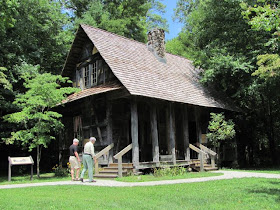We got with our hiking friend, Sharon, and she suggested we go up to Brushy Mountain via the Trillium Gap Trail. That was a great suggestion and it turned out to be a beautiful hike.
Trillium Gap Trail is one of the four trails which lead to Mt. LeConte Lodge. The others are Rainbow Falls Trail, Alum Cave Trail, and The Boulevard Trail. Of course, there are other trails which make connections with these making other routes possible. Brushy Mountain Trail junctions with Trillium Gap Trail and Bull Head Trails junctions with Rainbow Falls Trail.
Trillium Gap Trail is nine miles long from its trailhead in Cherokee Orchard to LeConte Lodge. For our hike today we were only doing a short 2.8 mile section, or what is commonly thought of as the middle section of Trillium Gap Trail. To access the middle of the trail we didn’t use the large parking area at the trailhead. Trillium Gap Trail actually begins off of Rainbow Falls Trail a short distance from that trailhead. After leaving Rainbow Falls Trail, Trillium Gap Trail more or less parallels Cherokee Orchard Road for about two miles at which point a short access trail comes up from the Grotto Falls parking area. We used this access trail as a means to get to Trillium Gap Trail without having to start at the beginning.

The Grotto Falls parking area is about 2 miles from the beginning of the one-way Roaring Fork Motor Nature Trail. The parking lot will accommodate several cars, but this is one of the most popular hikes in the park, so the spaces go quickly. Also, because this trail leads to Mt LeConte, some vehicles will be there overnight. We arrived about 9 AM and were able to find a parking space near the end of the lot and didn’t have to try to squeeze to the shoulder of this very narrow road.
 |
| Lower portion of Grotto Falls |
The primary feature along this trail is Grotto Falls located just 1.4 miles from the parking area. It is a relatively easy climb on a wide, well used trail to one of the prettiest falls in the Park. No wonder it gets crowds every day. On the morning of our hike, we only saw 3 or 4 other people on the trail as we made our way past the falls.
Roaring Fork, the source of Grotto Falls, drops approximately 25 feet as it falls over the rock outcrop into a small pool then quickly tumbles again over boulders as it rushes on its journey to join the West Prong of the Little Pigeon River near Gatlinburg. There are boulders all around the falls. Sometimes they seem to be in the way of the best camera shot, but they make great places to sit and enjoy the beauty of the falls.
The trail actually goes behind the falls. This can be a wet spot depending on the amount of recent rainfall, but we only got a little spray on our boots as we passed behind the falls. Grotto Falls is the destination for most hikers on this trail. We, however, we continuing beyond the falls up to Trillium Gap where we would junction with Brushy Mountain Trail.
Even on days when there are crowds at the Falls, the trail above the falls is blessedly peaceful. There may be the occasional day hikers like ourselves or the few guests coming or going from Mt LeConte Lodge, but certainly not the throngs of folks that clog the trail below the falls.
This is also the trail which the wrangler uses to lead the llamas to and from Mt Leconte Lodge. The llama trailer was in the parking area and there was evidence on the pavement and on the trail that they had been there earlier that morning. I’m sorry we missed them. That would have been a real treat to see.
The trail above the falls becomes a bit steeper, but not too strenuous as it gains another thousand feet before meeting Brushy Mountain Trail in Trillium Gap. The gap is a large grassy spot with a couple of logs to sit on for a break. In the middle of the gap is a 4-way intersection. Trillium Gap Trail makes a sharp right turn here to continue on to Mt. LeConte. Straight ahead of us as we came up Trillium Gap Trail is Brushy Mountain Trail. To go straight here would lead 5.5 miles to Greenbrier Cove. Our destination was to the left about a quarter mile up to the summit of Brushy Mountain.
 |
| Trail on Brushy Mountain |
Brushy Mountain is a heath bald which offers some tremendous views. This is different from the grassy balds we’ve been visiting this summer. A heath bald is covered in short shrubs of the heath family--blueberry, sand myrtle, wintergreen, rhododendron, and mountain laurel. These shrubs can get pretty tall and I was barely able to see over the top. Fortunately, there is a “bald” spot just off the trail that offers excellent views. This is also a great spot for lunch as it is somewhat protected from the wind by the surrounding vegetation.
 |
| Mt LeConte just under the cloud |
A few rumbles of thunder and an ominous looking black cloud approaching from over Mt LeConte cut our lunch break a little short. We packed up our stuff and headed back down the mountain. Our return trip along Trillium Gap Trail was as peaceful and pleasant as our ascent had been until we got to Grotto Falls. The crowds had moved in and we had difficulty navigating our way behind the falls and over the surrounding boulders.
 |
| Lunch spot of the day |
I guess I’m selfish and enjoy the solitude of a mountain trail. At the same time, I’m grateful all these people chose to venture out into the woods for a day of exercise, fresh air, and a big dose of nature at its best.
 |
| View from our lunch spot |
This is a beautiful hike and we’ll be coming here often. Thanks, Sharon, for sharing the hike and the day with us.
That’s all for now. Thanks for tagging along.
























































